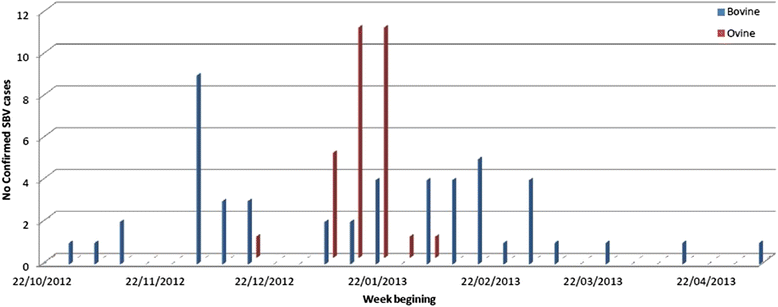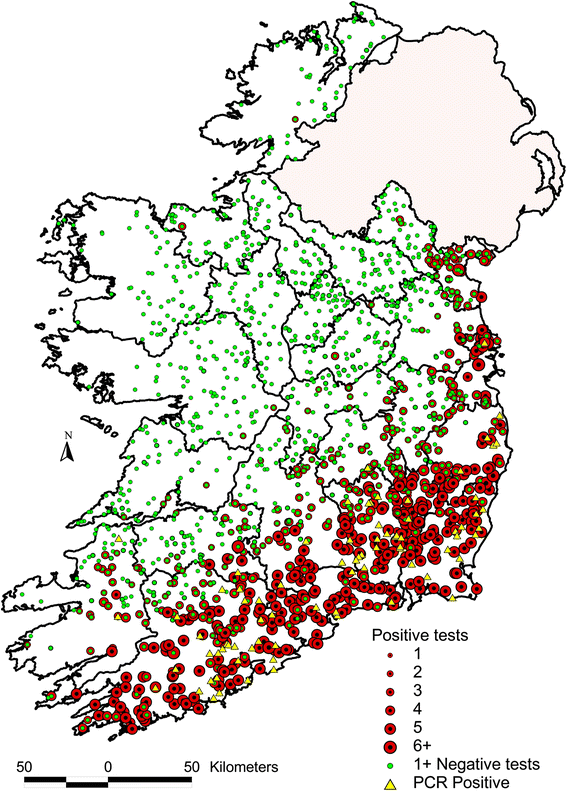Prevalence and distribution of exposure to Schmallenberg virus in Irish cattle during October 2012 to November 2013
- PMID: 26486852
- PMCID: PMC4618175
- DOI: 10.1186/s12917-015-0564-9
Prevalence and distribution of exposure to Schmallenberg virus in Irish cattle during October 2012 to November 2013
Abstract
Background: Schmallenberg virus (SBV) was first identified in November 2011. It is a novel Orthobunyavirus (family Bunyaviridae) whose main ill effect is congenital malformation of the musculoskeletal and central nervous systems. It is borne by Culicoides spp., and has spread extensively in western Europe. The first case of SBV in Ireland was diagnosed in October 2012. It was anticipated that once the virus emerged in Ireland that there would be wide scale or nationwide spread over the course of the 2013 vector season. The objectives of this study were to determine the seroprevalence and distribution of exposure to Schmallenberg virus in Irish cattle from November 2012 to November 2013.
Methods: Samples of brain for the pathology based surveillance were collected from malformed bovine and ovine foetuses submitted for post mortem examination. These samples were tested for SBV using RT-qPCR. Three serological surveys were carried out on sera submitted for the national brucellosis eradicartion programme. A spatial analysis of both sets of data was carried out.
Results: Between October 2012 and 10th May 2013, SBV was confirmed by RT-qPCR in brain tissues from malformed foetuses obtained from 49 cattle herds and 30 sheep flocks in Ireland. In national serosurveys conducted between November 2012 until November 2013 the herd-level and animal-level SBV seroprevalences in cattle were 53 and 36 % respectively for the first survey, 51 and 35 % for the second survey and 53 and 33 % for the third survey. The herd level seroprevalence in counties ranged from 0 to 100 %, with the counties in the south and southeast having the highest seroprevalence (>50 %), the midlands a moderate herd level seroprevalence (10-50 %) while northern and north western counties had a low herd level seroprevalence (0-10 %). There was close spatial agreement between the results of the two different targeted surveillance strategies.
Conclusions: At the end of the 2012 vector season, there was widespread exposure to SBV among herds in southern and south eastern Ireland. During 2013, there was little or no evidence of further outward spread, unlike the situation in several other European countries. Given the lack of evidence for circulation of the virus since 2012, it is likely that the younger age cohort in herds previously exposed to SBV and substantial proportions of animals of all ages on the margins of affected areas are immunologically naïve to SBV, and would be susceptible to infection if the virus were to re-emerge.
Figures




Similar articles
-
Post-epidemic Schmallenberg virus circulation: parallel bovine serological and Culicoides virological surveillance studies in Ireland.BMC Vet Res. 2016 Oct 18;12(1):234. doi: 10.1186/s12917-016-0865-7. BMC Vet Res. 2016. PMID: 27756302 Free PMC article.
-
Schmallenberg virus in Dutch dairy herds: potential risk factors for high within-herd seroprevalence and malformations in calves, and its impact on productivity.Vet Microbiol. 2014 Jan 31;168(2-4):281-93. doi: 10.1016/j.vetmic.2013.11.021. Epub 2013 Nov 28. Vet Microbiol. 2014. PMID: 24360813
-
Schmallenberg Virus beyond Latitude 65°N.Transbound Emerg Dis. 2015 Oct;62(5):e11-8. doi: 10.1111/tbed.12195. Epub 2013 Dec 11. Transbound Emerg Dis. 2015. PMID: 24330506
-
Schmallenberg virus: a new Shamonda/Sathuperi-like virus on the rise in Europe.Antiviral Res. 2012 Aug;95(2):82-7. doi: 10.1016/j.antiviral.2012.05.014. Epub 2012 Jun 5. Antiviral Res. 2012. PMID: 22684044 Review.
-
Schmallenberg virus: a systematic international literature review (2011-2019) from an Irish perspective.Ir Vet J. 2019 Oct 9;72:9. doi: 10.1186/s13620-019-0147-3. eCollection 2019. Ir Vet J. 2019. PMID: 31624588 Free PMC article. Review.
Cited by
-
Serological prevalence of the Schmallenberg virus in domestic and wild hosts worldwide: a systematic review and meta-analysis.Front Vet Sci. 2024 Mar 28;11:1371495. doi: 10.3389/fvets.2024.1371495. eCollection 2024. Front Vet Sci. 2024. PMID: 38605927 Free PMC article.
-
Post-epidemic Schmallenberg virus circulation: parallel bovine serological and Culicoides virological surveillance studies in Ireland.BMC Vet Res. 2016 Oct 18;12(1):234. doi: 10.1186/s12917-016-0865-7. BMC Vet Res. 2016. PMID: 27756302 Free PMC article.
-
Sampling Methodology to Maximize the Efficient Use of National Abattoir Surveillance: Using Archived Sera to Substantiate Freedom From Bluetongue Virus Infection in Ireland.Front Vet Sci. 2018 Oct 24;5:261. doi: 10.3389/fvets.2018.00261. eCollection 2018. Front Vet Sci. 2018. PMID: 30406120 Free PMC article.
-
A survey of free-ranging deer in Ireland for serological evidence of exposure to bovine viral diarrhoea virus, bovine herpes virus-1, bluetongue virus and Schmallenberg virus.Ir Vet J. 2017 May 12;70:13. doi: 10.1186/s13620-017-0091-z. eCollection 2017. Ir Vet J. 2017. PMID: 28503294 Free PMC article.
-
Blood-feeding, susceptibility to infection with Schmallenberg virus and phylogenetics of Culicoides (Diptera: Ceratopogonidae) from the United Kingdom.Parasit Vectors. 2018 Feb 27;11(1):116. doi: 10.1186/s13071-018-2650-x. Parasit Vectors. 2018. PMID: 29486789 Free PMC article.
References
MeSH terms
LinkOut - more resources
Full Text Sources
Other Literature Sources
Miscellaneous

